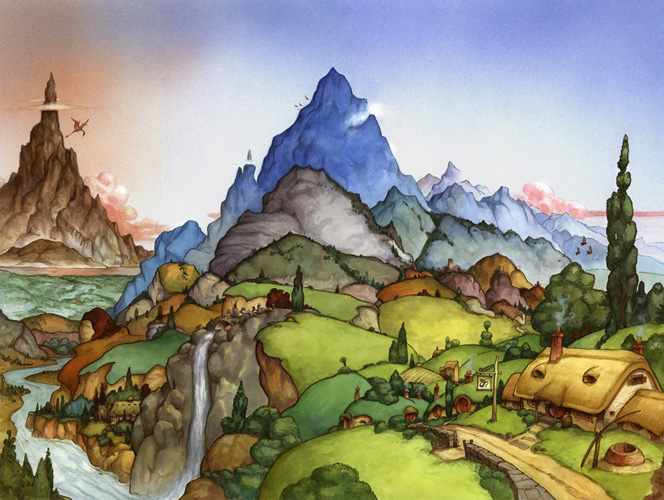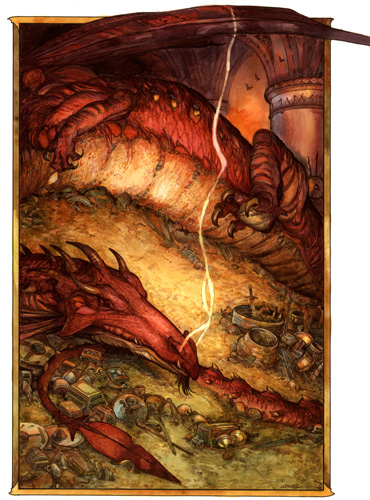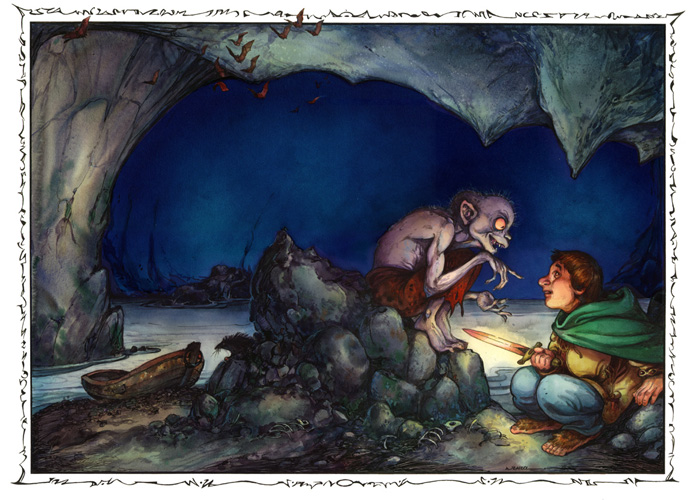Last year at New York Comic Con, I combed my way through all the aisles looking for anything Tolkien related. Sadly, there wasn’t much, and when I went into Artist Alley, I made sure to pay close attention in case there was a hobbit or wizard illustration nearby. Right when I was about to give up hope, something caught my attention. It was David Wenzel’s artwork from The Hobbit graphic novel, which was written by Chuck Dixon. Once I saw his table, I got so excited; not only is his artwork beautiful, but his illustrations have been some of my favorites since I was a child. I, of course, couldn’t resist, and I ended up buying a signed print of Smaug, which is displayed proudly in my Tolkien collection.
David Wenzel has created artwork for a variety of children’s books and stories such as The Wizards Tale by Kurt Busiek, Rudolph the Red Nosed Reindeer by Robert L. May and Little Bear. You can read more about him on his official website. I am so happy that I had the opportunity to interview David and learn more about him and his art.
Middle-earth News: What is your background in art?
David Wenzel: My artistic background goes way back to when I remember drawing comic strips when I was about six years old. Pretty soon I realized that I wanted to draw for a living, which was pretty much the only skill I excelled at. I did go to an Art College and graduated with a BFA. After that I pursued a career in freelance art, which I have been working at ever since.
I really love narrative story telling. Taking the written word or one of my own ideas and translating that into an image is rewarding. The artists that I have always been drawn to are artists who tell a story with images. The process of crafting an image that is rich in detail and has a compositional path that winds the viewer through the piece is something I have always enjoyed and strive for in my more complicated pieces.
M-e News: How did you become a Tolkien fan?
DW: Several friends told me about The Hobbit when I was in college. When I read it I was absolutely enthralled by the land and the inhabitants of Middle-earth. It was a work that I felt spoke to young and old and I wanted to draw scenes of what I was being inspired by. I immediately switched all my artistic endeavors to visualizing The Hobbit and then The Lord of the Rings. For my senior graduation show in college I produced an entire gallery of artwork, which included color and ink illustrations, maps and life sized stand-ups of Hobbits and dwarves. I actually illustrated the entire Hobbit in circular motifs that were later reworked and incorporated into the book Middle-earth the World of Tolkien Illustrated.
M-e News: What was it about his works that drew you in?
DW: I think Tolkien inspired me for the same reasons his work appeals to many other readers. The hero’s quest within the boundaries of wonderful a fantasyland that echoes of medieval history and magic. After generations of fantasy like Harry Potter and Dungeons and Dragons we can easily forget before The Hobbit and The Chronicles of Narnia there were not a lot of medieval fantasies that were making it into the main stream. It took a while for them to spark the public and I think the 1960’s generation was ready to escape into Tolkien’s world. After all the first inlkling I had of Tolkien were the bumper stickers that read, FRODO LIVES. There were actually auditions advertised for a Hobbit movie in the late Sixties that had people like Donovan interested in trying out for various parts.
M-e News: I’m fascinated by your landscapes in The Hobbit graphic novel, especially for The Shire! What would you say was the most fun to draw?
DW: Thank you I appreciate your noticing the landscapes. I enjoy all of locals that The Hobbit passes through and you are right in that The Shire was always my favorite, I grew up in a rural New England town that had rolling hills and beautiful meadows and orchards. When I draw the Shire I use my imagination but I use my childhood memories for my inspiration. The Tolkien estate is very fond of the artists that focus on the landscapes of Middle-earth even more than visualization of the characters. I have always appreciated the way Ted Naismith breaks down the settings and tries to really paint to Tolkien’s descriptions.
M-e News: What was your process when you were drawing your Hobbit illustrations? Did you get to put a lot of your own visions into it? How much input did the publishers have?
DW: The process for creating the graphic novel was pretty developed into a really nice little system. I worked with Sean Deming, the editor. He would send me Chuck Dixon’s scripts and then I would divide the script into 10-page sections and do breakdowns and thumbnails of the ten pages. I used Chuck’s script and the book as my guides for making the panel breakdowns. I then made pencil finishes, which were sent to Sean and Cat Yronwode at Eclipse for approval. Once I received approval on the sketches I inked and painted those ten pages before going on to the next batch of 10.Once the story was in my hands I could visualize and interpret Tolkien’s story pretty much as to my vision of what it should be. Sean and I were on the same page and there were remarkably few revisions of any kind.
M-e News: Did the animated Hobbit film influence you at all?
DW: I saw The Hobbit animated film and it really had no influence on me at all. I had seen pre-production art that reflected that Arthur Rackham’s illustrations were inspiring the Hobbits, but when it finally came out they had lost that look and I was disappointed as I wanted it to be more then a made for TV movie.
M-e News: Do you have any favorite Tolkien related pieces by other artists?
DW: Of course, I enjoyed Alan’s and John’s work for many years before I saw their Tolkien work. I have a first edition of Fairies, which Alan Lee and Brian Froud so masterfully created and all of the Time Life Fantasy books the John painted for. Luckily for me when I painted The Hobbit they had not published their Tolkien paintings yet so I was able to create my own unique view of The Hobbit without the influence of their hallmark visions.
John, Alan and Ted Naismith are artists, that to me, understand and capture the mood of Tolkien’s text. That being said I have several other artists I really enjoy, who translate Tolkien’s words into paintings. Donato Giancola does amazing paintings and I was fortunate to have one of his works on the cover of one of The Hobbit graphic novel editions. I also very much enjoy Justin Gerard’s Hobbit paintings and The Hildebrandt’s paintings.
M-e News: What is your opinion on The Hobbit trilogy? I admit that during Bilbo and Gandalf’s first scene together, I thought of your illustrations!
DW: I’ve enjoyed the Peter Jackson Hobbit movies. They are more of a thrill ride then an exact telling of the story in the book. The reworking of the original text makes the movies more appealing to a broader audience. I think Martin Freeman is absolutely a fantastic Bilbo and Smaug was a great treat. Since the movies depart from the original text to such a degree it leaves my graphic interpretation as the closest sequential visualization to the original book. So that keeps me happy.
M-e News: Over two decades later and The Hobbit graphic novel is still popular among fans. What is it like to know that new generations of Tolkien fans are picking it up and reading it? It certainly helped me understand The Hobbit better.
It’s very touching to go out and meet with people that grew up with my version of The Hobbit. I always enjoyed the story because I felt its message was timeless and that makes the artwork have a longer shelf life then other projects I’ve worked on. I love the idea that new fans are connecting with my art and I hear over and over again how Mom’s and Dad’s read it to their children and the kids follow along with the pictures.
You can see more of David’s work on his official website and if you are interested in owning your own print, you’re in luck! Make sure to check out all of his prints for sale.







2 Comments